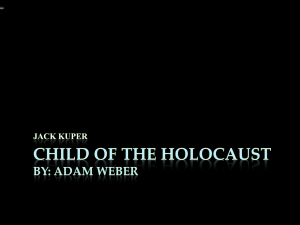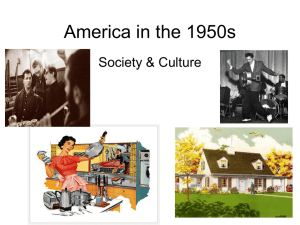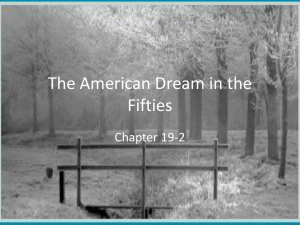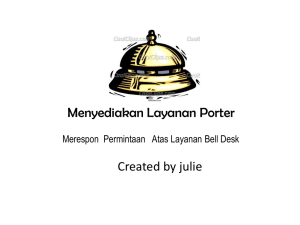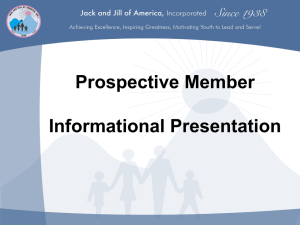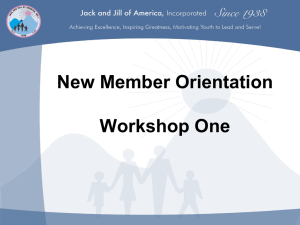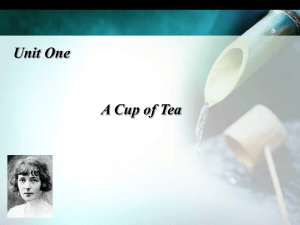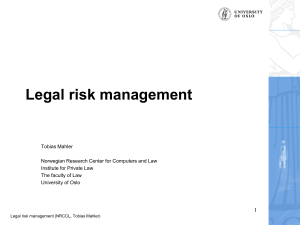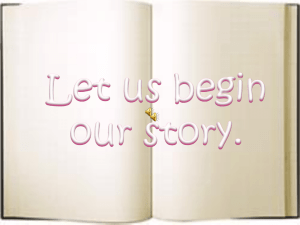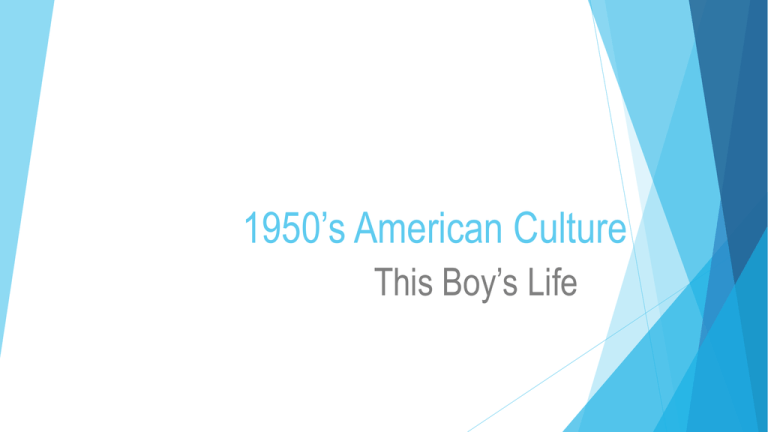
1950’s American Culture
This Boy’s Life
Pictures
These pictures are of
the places spoken about
in This Boy’s Life and
provide a visual
framework for the
memoir.
Pictures
Pictures
Pictures
FASHION
Prior to the 1950’s, teen clothing very reserved/ proper but
to some extent that changed in the 50’s.
Guys
Hair longer w/ sideburns and slicked back with grease.
Jeans
Leather jackets (collar turned up to be “cool”)
Girls
Ponytails
Pedal pushers, Scarves.
Poodle Skirts popular because
1) Easier dancing, being spun around letting the skirt twirled.
2) skirt was loose and free, a sign of freedom.
THE 1950s:
“Conservatism,
Complacency, and
Contentment”
OR
“Anxiety, Alienation, and
Social Unrest” ??
The American Dream – Post War morality and fear
We tend to imagine the Fifties as a tranquil decade, but in fact Americans
spent the years moving and searching. They moved physically, from the
Northeast to the South and West—California's population grew by 49% during
the Fifties, Florida's by 79%.
They moved from rural areas to cities and from cities to suburbs. By 1960, a
third of the country's population lived in the 'burbs.
Many people were content, but many others felt ill at ease because of the
speed at which the world was changing. Searching for new ways of coping,
they embraced religion.
The American Dream – Post War morality and fear
1950s suburbia was desperate not to reveal any moral or psychological
family scars, especially after the trauma of the Depression and all the
casualties of World War II. America wanted another age of innocence,
and suburbia, with its quiet tree-lined streets, its two-car garages, its
chain link fences, would repackage all of America’s twenty to thirty
years of social trauma
In the face of change, people craved rules and boundaries, with a
significant increase in religious fervour and, through TV, the
dissemination of gender roles and the need for conformity and order.
These values were linked to the idea of an “All American” lifestyle
and patriotism, and any deviation from this was associated with
Communism.
Morality
Fairly Strict Society – monitored by society itself
Rebellion was not acceptable
Surge in Religion – felt good indicator of Anti-Communist
Added “Under God” to the Pledge of Allegiance
Gender Roles strongly held
SOCIAL CONFORMITY
American workers found themselves
becoming standardized
Called the “Organization Man,” the
modern worker struggled with a loss of
individualism
Businesses did not want creative
thinkers, rebels or anyone that would
“rock the boat”
Despite their success, some workers questioned whether pursuing the
American dream exacted too high a price, as conformity replaced
individuality
The increasing role of media
Social control vs. Globalisation
POPULAR CULTURE
A new era of mass
media led by
television emerged
in the 1950s
In 1948, only 9% of
homes had T.V
In 1950, 55% of
homes had T.V.
By 1960, 90% of
American homes
had T.V.
THE ADVERTISING AGE
The advertising industry
capitalized on runaway
consumerism by encouraging
more spending
Ads were everywhere
Ad agencies increased their
spending 50% during the 1950s
Advertising is everywhere today in
America
THE GOLDEN AGE OF
TELEVISION
The 1950s was known as the
“Golden Age of Television”
Mass Audience TV
celebrated traditional
American values.
Comedies were the main
attraction as Milton Berle,
Lucille Ball and Desi Arnaz
were very popular
Desi Arnaz and Lucille Ball
starred in I Love Lucy
Changes in TV
On-The Scene Reporting
Game Shows – offered large cash
prizes
Businesses spent $$$ on TV
Advertising
$170 million in 1950
$1 billion by 1955
$2 billion by 1960
TV Guide = HUGE magazine, TV
Dinners created so did not have to
miss favorite show
Television – The Western
Davy Crockett
King of the Wild Frontier
Sheriff Matt
Dillon, Gunsmoke
The Lone Ranger
(and his faithful
sidekick, Tonto):
Who is that masked man??
Family Shows
Glossy view of mostly
middle-class suburban life.
But...
I Love Lucy
Social Winners?...
The Honeymooners
AND…
Losers?
ELEVISION EXPERIMENTS WITH VARIOUS FORMATS
Television innovations like onthe-scene-news reporting,
interviews, westerns and sporting
events offered the viewer a
variety of shows
Kids’ shows like The Howdy
Doody Show and The Mickey
Mouse Club were extremely
popular
TV ADS, TV GUIDES AND TV DINNERS EXPAND
TV advertising soared from $170 million in 1950 to nearly $2 billion in
1960
TV Guide magazine quickly became the best selling magazine
Frozen TV dinners were introduced in 1954 – these complete ready-toheat meals on disposable aluminum trays made it easy for people to
eat without missing their favorite shows
LEISURE IN THE 1950s
Americans experienced shorter
work weeks and more vacation
time than ever before
Leisure time activities became a
multi-billion dollar industry
Labor-saving devices added more
spare time
Labor-saving
devices
provided
more leisure
time for
Americans
POPULAR LEISURE ACTIVITES
In 1953 alone Americans spent
$30 billion on leisure
Popular activities included
fishing, bowling, hunting and
golf
Americans attended, or watched
on T.V., football, baseball and
basketball games
Bowling remains
one of the top
leisure activities
in the U.S.
Family
THE AMERICAN DREAM IN THE 50’s
After WWII ended,
Americans turned their
attention to their families
and jobs
New businesses and
technology created
opportunities for many
By the end of the 1950s,
Americans were enjoying
the highest standard of
living in the world
Ozzie and Harriet reflected
the perfect American family
THE SUBURBAN LIFESTYLE
The American Dream complete with
a white picket fence
Most Americans worked in
cities, but fewer and fewer
of them lived there
New highways and the
affordability of cars and
gasoline made commuting
possible
Of the 13 million homes
built in the 1950s, 85% were
built in suburbs
For many, the suburbs were
the American Dream
The Nuclear Family
In the 1950's the ‘normal’ American family consisted
of a breadwinner father, homemaker mother, and
several children, all living in homes in the suburbs on
the outskirts of a larger city. It was a narrow view of
a model family, yet it pervaded the media and was
widely accepted as the ideal and most normal.
REDEFINING THE FAMILY
After WWII American society dictated that a return to
traditional roles was the norm and should be something
that all people strive for
Men were expected to work, while women were expected
to stay home and care for the children
Conflict emerged as many women wanted to stay in the
workforce
Divorce rates surged
DR. SPOCK ADVISES PARENTS
Many parents raised their
children according to the
guidelines of pediatrician
Dr. Benjamin Spock
He thought children should
be allowed to express
themselves and parents
should never physically
punish their kids
Dr. Spock’s book sold 10
million copies in the 1950s
IMPACT OF BABY BOOM
As a result of the baby boom 10
million students entered
elementary schools in the 1950s
California built a new school
every 7 days in the late ’50s
Toy sales reached an all-time high
in 1958 when $1.25 billion in toys
were sold
Symbols of the Baby Boom
in Suburbia
1950
1960
Hot Dog Production (millions of lbs)
750
1050
Potato Chip Production (millions of lbs)
320
532
Sales of lawn and porch furniture (millions of dollars)
53.6
145.2
Sales of power mowers (millions of dollars)
1.0
3.8
Sales of floor polishers (millions of dollars)
0.24
1.0
Sales of Encyclopaedia (millions of dollars)
72
300
Number of Children age 5-14
24.3
35.5
Number of baseball Little Leagues
776
5,700
Fads of the Baby Boomers
Hula Hoops
Frozen Foods
Poodle Skirts and Saddle Shoes
What celebrity deaths have most
affected the Baby Boomers?
Panty Raids
John F. Kennedy
Barbie and GI Joe Dolls
Bikinis
Marilyn Monroe
Frisbees
Martin Luther King
Yo-yos
John Lennon
Ouija Boards
Dune Buggies
Gender Roles and expectations
Gender Roles in the 1950s
The emerging popularity of American television helped
shape gender roles for both men and women through the
1950s. Expanding families and young children were reared
in a TV generation, where gender roles were clearly
defined by the societal ideal. Shows like the 1954 sitcom
"Father Knows Best" established in the title the patriarchal
sentiment of the decade, where men not only were the
primary breadwinners but ultimately presided over the
family unit itself.
WOMEN’S ROLES IN THE 1950S
During the 1950s, the role
of homemaker and mother
was glorified in popular
magazines, movies and
television
Caring mothers, diligent
spouses, obedient partners,
and "good" wives. They
were expected to carry out
her man's every order and
agree with him on
everything. A good wife
always knew her place.
Well-Defined Gender Roles
The ideal modern woman married, cooked and
cared for her family, and kept herself busy by
joining the local PTA and leading a troop of
Campfire Girls. She entertained guests in her
family’s suburban house and worked out on the
trampoline to keep her size 12 figure.
-- Life magazine, 1956
Marilyn
Monroe
The ideal 1950s man was the provider, protector,
and the boss of the house. -- Life magazine, 1955
1956 William H. Whyte, Jr. The
Organization Man
A
a middle-class, white suburban
male is the ideal.
WOMEN AT WORK
Higher education for women was not valued
within society, however, when American men
went to war, women had no choice but to
enter the workforce, in part because industry
needed to continue, and in part because they
needed to earn a wage to support their
families.
When men returned from the war many
women did not want to return to their
Homemaker status and wanted to remain
working.
However, those women who did work were
finding job opportunities limited to fields
such as nursing, teaching and office support
Women earned far less than man for
comparable jobs
Men’s roles in the 1950s.
While it is true that women experienced very prescriptive gender roles in the
1950’s, so too did men.
Little girls were expected to play with dolls like Barbie, but we also had the boy
toys like the GI Joe. This toy represented that men were strong, had courage, and
was "America's Movable Fighting Man." This was new territory in imaginative play
for boys - G.I. Joe was not a "doll" he was an "action figure.“
Men were considered “real men” if they were either the strong silent type or the
tough, “you-talkin’-to-me?” street type with their ducks-ass hair style and pack of
Lucky Strikes rolled up inside their short t-shirt sleeve.
These “real men” played sports and avoided the arts; loved manual labour and
hated desk jobs; were hard drinkers; drove stick shift; and dodged commitments,
especially marriage, until the 11th hour, after a brief courtship of prom night,
drive-ins, street dances, roller rinks, a summer at the beach, and making out in the
balcony back row at a movie theatre.
A “man in a uniform,” fresh from active duty, always had the upper hand on the
street. Women in the 1950’s generally loved a guy in a uniform.
Men’s roles in the 1950s.
As the head of the family, the man is expected to be the bread winner, the
one who works hard to earn a wage, so that he can financially support his
family. In the 1950s, most husbands had attended college or vocational
training. Their educational background afforded them the opportunity to find
a job.
Men had a great deal of pressure on them to ensure that they supported and
protected their families, needing to demonstrate wisdom, strength, bravery
and unemotional detachment almost on demand.
Just as the women were bombarded with images in which they were supposed
to live up to, the men were expected to be a blend of the classic American
Cowboy, the American War Hero, the wise and steady Father (think Atticus
Finch). Finally, men were expected to keep an orderly household, a wife or
child that does not behave in socially acceptable ways reflects badly on him
and his ability to “discipline” them.
How is this explored in
This Boy’s Life?
The fact that a girl shared the name Tobias caused them both “scalding humiliation” p7
“I was subject to fits of feeling myself unworthy, somehow deeply at fault” Toby has an
inferiority complex, linked to his perceived need to wield power and demonstrate masculinity
p.9
Roy only partially fulfils gender expectations, “Roy didn’t work”p11, but he is a military veteran
and a proficient hunter. Also, in his own way, does a socially acceptable job of teaching Toby to
be ‘manly’ pp11-12.
As a 10yr old boy, “I thought Roy was what a man should be” p12.
“Power can only be enjoyed when it is recognised and feared” p21
Dwight’s insistence on getting drunk at the tavern and then driving dangerously home when
his masculinity is threatened – after the rifle club competition (pp109 -113), while he is
courting Rosemary (pp74-76, 83)
The construction of the teenage
identity
Teen Culture
Behavioral Rules of the 1950s:
Obey Authority.
Control Your Emotions.
Don’t Make Waves Fit in
with the Group.
Don’t Even Think About Sex!!!
Teen Culture
EMPHASIS ON YOUTH IN 1950s. First time the term Teenager
was used.
Drive-in movies – Good for dates
Sock Hops – informal High School dance
Fast food restaurants
TV in 90% of homes by 1959
How is this explored in This Boy’s Life?
The title of the memoir: Wolff’s choice of pronoun This – it is decisive and assertive – not,
for example, My Life as a Boy (apart from the obvious ambiguities…) or A Boy’s Life, or
even My Life by Tobias Wolff.
His choice of This is indicative of his struggle to define himself during this period of his
life – this is the account of his years as Jack.
What we are to discover is that throughout the memoir, Wolff is more than one boy – one
who is not so much defined by his identity but by his search for identity. If there is one
framing narrative of this work, it is captured by that pronoun: This – this boy is Jack, as
remembered and described by Tobias Wolff, the man.
Simultaneous narratives run throughout This Boy’s Life; sometimes parallel, sometimes
converging – these are the accounts of Jack’s reality and his fantasies.
How is this explored in This Boy’s Life?
Tobias, as his father before him had done, wanted to change his name to Jack, feeling that
it was more masculine. (p7.) The insight is less about the name, and more about the
pervading need to create a heritage to be proud of – but that the reality is, it is always a
construction, both by individuals and by society.
“Being close to so much robust identity made me feel the poverty of my own, the ludicrous
aspect of my costume and props” p23.
Building a sense of self is an on-going process, but the events of the first basketball game
are the moment Toby realises that way will not be one of cruelty – p108
How is this explored in This Boy’s Life?
Moments of crisis often accompany the intersecting of reality
and fantasy:
When Sister James pays a visit to Jack, who is at the time engaging
in a sniper fantasy (p. 22/23)
When Jack scratches profanities onto the bathroom wall at school,
after his friends Taylor and Silver cast doubt on his account of the
Turkey shoot (p. 63) This arguably* (you decide!) precipitates
Rosemary’s decision to send Jack to Chinook and to accept
Dwight’s proposal.
How is this explored in This Boy’s Life?
When Jack successfully campaigns to go to Paris – but is
unable to follow through (p.119) – interestingly, his key
explanation is that he does not want to change his name.
(Would this be a threat to the identity which he is
constructing?)
Following Jack’s acceptance into Hill, where he proves
unable to sustain the fantasy
How is this explored in This Boy’s Life?
Like Rosemary, Jack is optimistic that a new life will bring a change in fortune;
“I was caught up in my mother’s freedom, her delight in her freedom, her dream of
transformation.” (p.4)
Jack takes this ideal one step further, by rewriting his personal narrative/s to pre-empt
this change. (As he does when applying for Hill.)
How is this explored in This Boy’s Life?
“Introduce myself as a scholar-athlete, a boy of dignity and consequence, and without any
reason to doubt me people would believe I was that boy, and thus allow me to be that boy”Important quote because after Jack and his mom leave Dwight for the first time he’s
always talking about how he wants to be a new person, a cool person. This is another
reason why Jack uses his imagination to escape reality.
“It was truth known only to me, but I believed in it more than I believed in the facts
arrayed against it. I believed that in some sense not factually verifiable I was a straight-A
student. In the same way, I believed I was an Eagle Scout…. And on the boy who lived in
their letters, the splendid phantom who carried all my hopes, I saw, at last, my own face”
Industry and Employment
Consumerism
Industry and Employment
White Collar jobs expanded
greatly in the 1950s
During the 1950s, businesses
expanded rapidly
More and more people held
“white-collar” jobs clerical, management, or
professional jobs
The fields of sales,
advertising, insurance and
communications exploded
Automobile Revolution
The Automobile Culture
After the rationing of WWII, inexpensive and plentiful
fuel and easy credit led many to buy cars
By 1960, over 60 million Americans owned autos
The Automobile Culture
Car registrations: 1945 25,000,000
1960 60,000,000
2-family cars doubles from 1951-1958
1958 Pink Cadillac
1959 Chevy Corvette
The Automobile Culture
America became a more homogeneous
nation because of the automobile.
First McDonald’s
(1955)
Drive-In
Movies
Howard
Johnson’s
How is this explored
in This Boy’s Life?
Men are always the drivers. Aspects of masculinity are explored throughout
the text in association with their car;
The man in the Thunderbird- “Young and handsome and fresh” p38, “he was on his
way to pick someone up”. The imperfect nature of the car as a symbol of
masculinity – so easily damaged. Pp38 – 39
* Silver screaming “Yid” at the driver. p39
As a symbol of masculinity itself – when Skipper’s car is damaged in the sandstorm,
his response is to cry, a feminine reaction in the 1950s
Tobias sneaks out and steals Dwight’s car, toying with the idea of running away,
branching out and being ‘grown up’
Interstate Highway System
INTERSTATE HIGHWAY ACT 1956
In 1956 Ike
authorized a
nationwide highway
network – 41,000
miles of road
linking America
The primary
purpose of the
highway system was
to support military
supply routes, and
to ensure that
there were clear
escape routes for
military vehicles in
the event of attack.
IMPACT OF THE HIGHWAY
The Interstate
Highway system
resulted in:
Trucking is the #1 means of
moving cargo in the United
States today
More trucking
Less railroad
More suburbs,
further away
HIGHWAYS “HOMOGENIZE” AMERICA
Another effect of the
highway system was
that the scenery of
America began to look
the same
Restaurants, motels,
highway billboards,
gas stations, etc. all
began to look similar
The nation had
become
“homogenized”
Anytown, USA
“Our new roads, with their
ancillaries, the motels, filling
stations, and restaurants
advertising eats, have made it
possible for you to drive from
Brooklyn to Los Angeles without a
change of diet, scenery, or culture.”
John Keats, The Insolent Chariots
1958
How is this explored in This Boy’s Life?
Metaphorically as well as literally, the Highways act as escape routes for Rosemary and
Tobias.
Tobias' mother is constantly moving locations to escape men, while Tobias' moves to his
imagination of hunting to escape from reality. Geography also helps characterize Tobias,
when he moves to colder weather his character also becomes colder resulting in
delinquent behaviours. Geography plays an important role in This Boy's Life because
when Tobias moves in with Dwight into a small town far from other towns. Toby begins
to feel trapped. The mountains enclose him and he feels certain there is no way to escape
this life.
How is this explored in This Boy’s Life?
When Rosemary and Tobias travel to a new location via car, it is often a tumultuous and
unhappy destination, such as the journey to Chinook. However, when they travel by bus
to Seattle, they find some semblance of calm and harmony.
“oh Toby…he’s lost his brakes” p3. Metaphor for their situation – they are beginning a
journey that they are powerless to stop.
Flight is played out numerous times in This Boy’s Life.
Since flight is symbolic of
freedom, every time Jack escapes from a place or situation, it is symbolic of flight. The
first instance of flight is when Jack and his mother escape to the West. Jack believes he is
free of who he used to be, and of hard times. But despite changing his name, this does
not turn out to be the case.
How is this explored in This Boy’s Life?
Jack encounters more problems in Chinook, where most of the memoir takes place. He
takes flight to live with Chuck and his family, to visit his father, and to go to Hill. But
each of these are examples of failed flights. Each time he fails, he discovers more about
himself and the world around him. This eventually leads him to discover his passion for
the army in which he gains successful “flight”. Wolff says that the army was “where I had
been going all along, and where I might still redeem myself” (Wolff 286). Chinook, his
father’s house, and Hill were not where he was supposed to end up, which is why his
flights failed.
Miscellaneous Metalanguage and
Quotes
Interesting dichotomies
Domesticated/Controlled vs. Wild/Uncontrolled
The relationship between Roy and Rosemary – Roy’s desperate need to control
Rosemary belied his own disbelief in his ability to ‘domesticate’ his partner, not
married to her, and ultimately unable to create a family of his own with her,
including but not limited to her not falling pregnant.
Chuck
Nature/Natural Processes/Unnatural Processes
Toby playing archery – the nun, and the construction of her religion vs. the ‘stand
of trees’ where the boys would revert to a more savage, some would argue, natural
state of interaction. P. 9
Juxtaposition of the Nun/church and Roy/family. Furthered through the
pronouns, father, sister etc.
Motifs
Guns
Guns exist as a symbol of power, who wields it, how it is exchanged and passed on, and also how it is lost or stolen. Jack has never felt
confident that he is in control of his life. He could never protect his mother from her horrible relationships or the economic hardships they
went through. However, with the rifle in his hands, he feels as if he had complete power. As he points it at objects and aims it at people, it
represents the advantage he feels he now has over them.
“the way it completed me when I held it” p19
Cars
Are indicative of change, or shifting sentiments
Norma and Bobby #1 – Toby realises he will never have a relationship with Norma when he realises that Norma and Bobby have had
sex. There is a hint of innocence lost, but it also is a moment of building his own sense of identity – a decision that he will not be a cruel
man p.108
Lying
Tobias was obsessed with everyone perception of him. He wanted everyone to think that he was some cool kid, but often struggled with
identifying what that actually looked like. Even in his letters to a pen pal when he was a little was a complete fabrication. He was obsessed
with being anybody but himself.
Motifs
Nature, most particularly animals, are represented as innocent victims of human brutality, stupidity or caprice:
•
(p.21) Jack shoots a squirrel. This is followed by extreme (but brief) remorse and the ironic comment that Rosemary “Like me, (she) was an
animal lover.”
•
(p.61) An early indication of Dwight’s nature – killing a deer with the car
•
(p.63) Rosemary’s story about the turkey farmers.
•
(p. 73) Dwight’s deliberate killing of the beaver – and the subsequent neglect and waste of its valuable pelt which is left to rot in the attic.
•
(p. 142) More on Dwight: “Dwight would shoot anything.” Followed by a list - none of the animals, it should be noted, are either edible or
valuable for their pelts. Reveals more of his destructive personality.
The bears at the tip are degraded by their contact with humans:
•
“And there were bears at the dump, rooting in garbage and rearing up now and then with cans stuck on their noses.” (p. 80) This image is
not one of a noble and powerful animal, but one which has become corrupted and clownish.
An exception is this image – (p. 62) as the fish move from coastal waters (Jack and Rosemary in Seattle) to the mountain rivers, the change
of environment kills them. Rosemary and Jack’s first visit to Chinook is concluded with this grisly image: They were already dying. The
change from salt to fresh water had turned their flesh rotten. Long strips of it hung off their bodies, waving in the current.
Facades
Motifs
Linked to the identity theme earlier, an ongoing idea is that all people create a false version of themselves
Tobias does this through the changing of his name, the construction of tales he shares with his penpal friend as
well as those around him and finally the clothing/costume he is fitted upon his entry to Hill
Dwight portrays himself falsely, generally in areas in which his masculinity is perceived to be lacking – his
hunting, driving, sociability and parenting skills, but this is also demonstrated when he paints the entire house
in Chinook white (p88) and later does the same to the Christmas tree (p123), each time Dwight is attempting to
sanitise (white is a significant, symbolic colour) his domestic life in an attempt to impress others.
Rosemary is not particularly good as facades and as such, avoids them however; “When she was worried she
wore a pale, tight-lipped mask…. Now the mask was gone. She looked young and pretty… As we walked we made
plans…. We were ourselves again—restless, scheming, poised for flight”
Tobias’ father – hinted façade early in the text re. the changing of his name, and the history of their families
religious leanings (‘always been Protestant. Episcopalian actually’ Actually, his family had been Jews, but I had
to wait another 10 years before learning this” pp7-8) but later, the significance of his façade was completed
when he left to get groceries and “had gone crazy and was now in the custody of the police” p239
Other symbols and themes
Violence is definitely an important aspect of This Boys Life. One of the first instances that comes to mind is the fight
between Arthur and Jack. This is the first confrontation between the two, and it goes from name calling, to swinging
fists and rolling down a hill. Though Arthur and Jack do not become friends right away, this was the sparking
incident that started their interactions. On the opposite end of the spectrum, violence is also used in This Boys Life to
portray hurt and resentment. This is seen between Dwight and Jack. Dwight is constantly abusing Jack both
physically and mentally, yet Jack does not allow to drag him down too far. Here the violence is used to portray the
perseverance in Jack's personality.
Jack is a healthy young boy with sight, but this may also mean that he doesn’t always see trouble coming. Jack’s
blindness results in his lack of being able to stand up to his cruel friends. It also results in his inability to know the
consequences of his actions.


